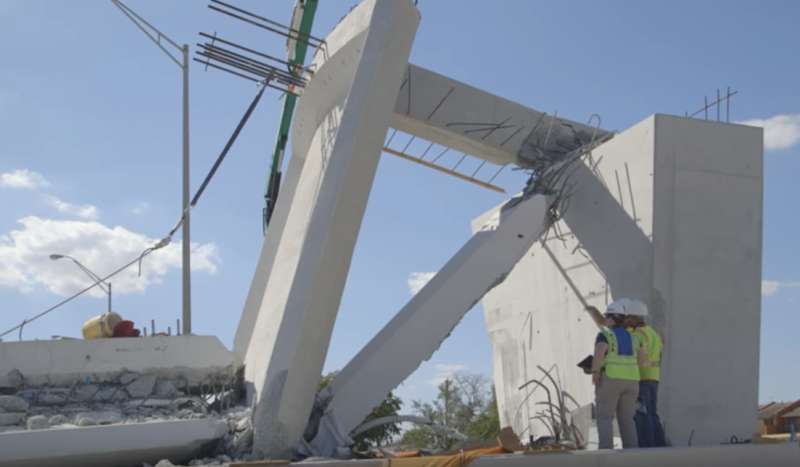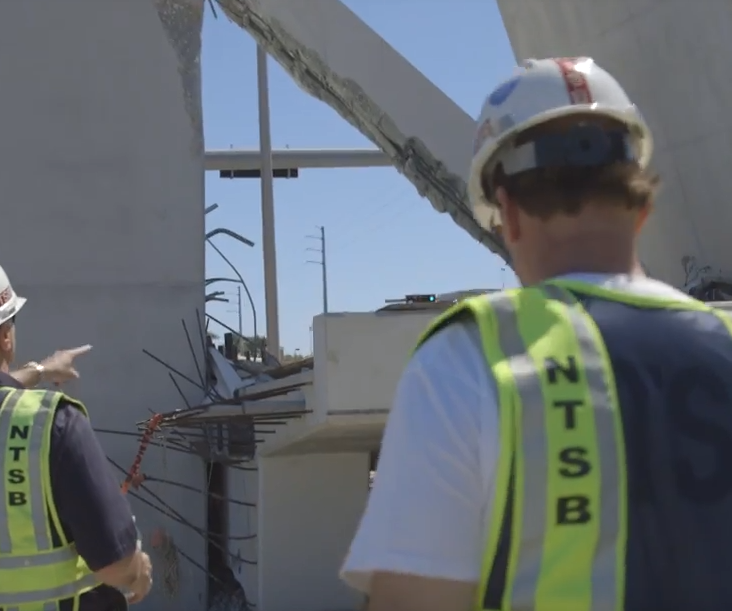To help get back on track. The failure of one pt strand in a 3" diameter duct
Why 3" diameter duct?
Where did you get 3" diameter from?
There is NO mention of a 3" diameter duct anywhere in the proposal pdf that I can see!
Show me, please.
would not have caused failure as is easy to see by calculation.
The cause and effect of a strand / tendon / bar breaking has got nothing to do the diameter of the duct it is in and everything to do with the diameter of the strand / tendon / bar and how much force (and stored energy) it is carrying when it breaks.
(It carries about 33,000 lbs which is a small fraction of the load.
On page B-13, page 111 of the proposal pdf, states for a 0.6 inch strand
"STRESSING FORCE SHALL BE 46 KIPS PER STRAND" or 46,000 lbs"
- which is possible with grade 270 KSI.
However, what makes you so sure that the bar which failed was a 0.6" tendon?
Take a closer look in this picture.
That looks much more like a 1.75 inch diameter P.T. BAR than a 0.6 inch diameter tendon to me.
In which case the proposal pdf, on Sheet B-17, page 115, recommends a P.T FORCE/BAR between 200 KIPS and 320 KIPS depending on the truss member concerned.
There is no specification for P.T FORCE/BAR given in the proposal pdf for member #11, which specifies ZERO P.T. bars, but the above photograph shows a bar nevertheless.
I understand that the construction plan intended to DE-STRESS truss member #11 bar after the mainspan was placed in situ.
I don't think that simply destressing the bar would have caused a problem.
Whereas if a 1.75 inch diameter bar was stressed by being over-jacked to failure, it might have failed at a force of something like
270 KSI x 2.4 square inches = 649 KSI
Loading above described as 1.7 times some factor of the dead load is OK) .
Sheet B-9, page 107 gives the approximate lifting weight of the mainspan as "915 tons"
1 ton = 2000 lbs, So
915 tons = 915 x 2000 = 1,830,000 lbs = 1,830 KIPS
Half weight of the mainspan =
0.5 x 1,830 KIPS = 915 KIPS
1.7 x 915 = 0.85 x 2 x 915 = 0.85 x 1,830 = 1555 KIPS
So the compressive load in member #11 was 1555 KIPS
Something else must have been wrong and tendon may have been the straw that broke the camels back.
I suggest to you that a 1.75" P.T. BAR over-jacked to failure would unleash an amount of energy rather more destructive than a "straw".
I think it was reported that people heard a loud CRACK and the New Civil Engineer article suggests an explosive failure of the bottom joint so maybe that's what did it?
The bridge was assembled beside the road in the south side of southwest 8th street and rotated in place. The pick up points had to be adjusted from the original proposal due to obstruction in the road way to the north. This moved the big trucks south and caused a portion of the bridge to cantilever during the assembly which would have necessitated the addition of tendons in the compression member that failed.
We can see one tendon / bar in the photograph attached to the jack.
I am not sure if that is another tendon / bar there, at the upper right of the picture? You can see something that looks like a bar sticking out of a tube, so maybe?
We are still waiting for the real smoking gun, the flaw that actually caused the collapse. If it does not show up soon, I intend to do a finite element analysis of the bridge to check what it should have had in it, but without the real reinforcing, it may not show much.
You don't think that the jack with the bar sticking out of the truss member shown in the picture is the "smoking gun"?
If it had not failed when it did, it might have held until it was full of students and failed then. Not a pretty thought.
Indeed.















